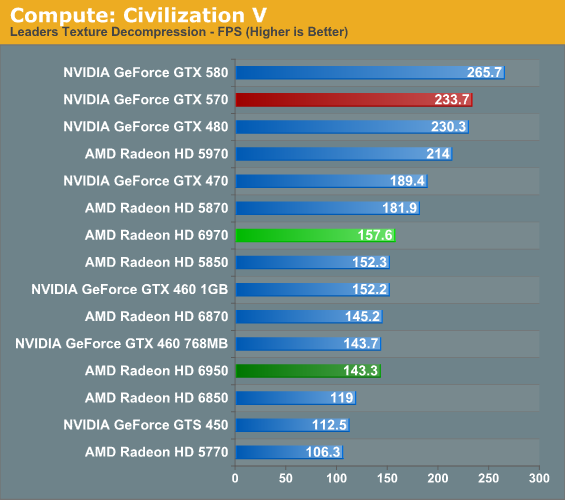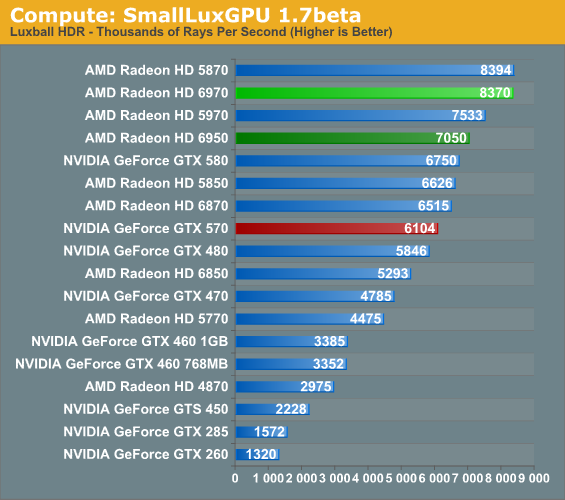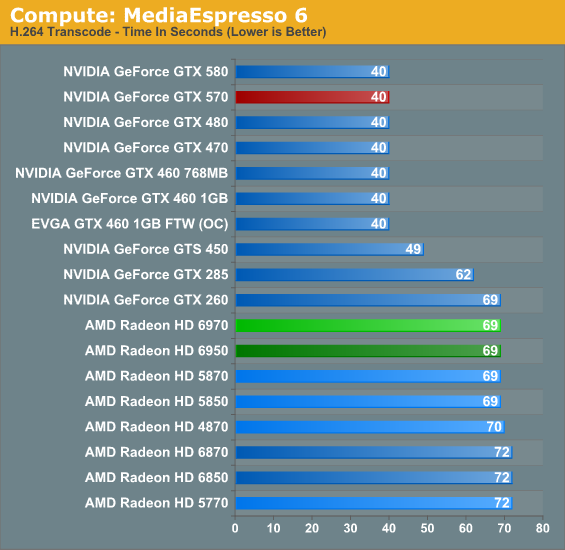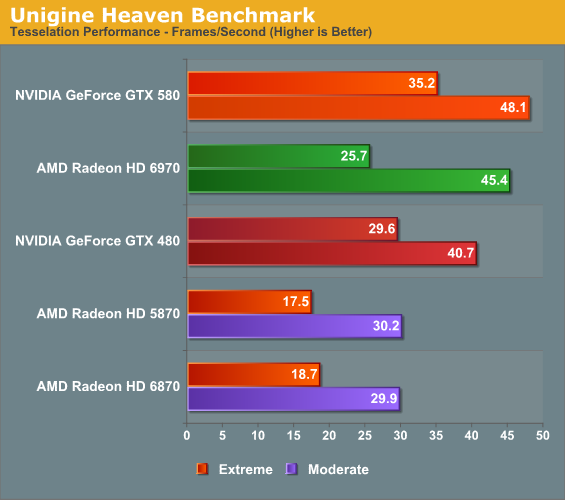AMD's Radeon HD 6970 & Radeon HD 6950: Paving The Future For AMD
by Ryan Smith on December 15, 2010 12:01 AM ESTCompute & Tessellation
Moving on from our look at gaming performance, we have our customary look at compute performance, bundled with a look at theoretical tessellation performance. This will give us our best chance to not only look at the theoretical aspects of AMD’s tessellation improvements, but to isolate shader performance to see whether AMD’s theoretical performance advantages and disadvantages from VLIW4 map out to real world scenarios.
Our first compute benchmark comes from Civilization V, which uses DirectCompute to decompress textures on the fly. Civ V includes a sub-benchmark that exclusively tests the speed of their texture decompression algorithm by repeatedly decompressing the textures required for one of the game’s leader scenes.

Civilization V’s compute shader benchmark has always benefitted NVIDIA, but that’s not the real story here. The real story is just how poorly the 6900 series does compared to the 5870. The 6970 barely does better than the 5850, meanwhile the 6950 is closest to NVIDIA’s GTX 460, the 768MB version. If what AMD says is true about the Cayman shader compiler needing some further optimization, then this is benchmark where that’s readily apparent. As an application of GPU computing, we’d expect the 6900 series to do at least somewhat better than the 5870, not notably worse.
Our second GPU compute benchmark is SmallLuxGPU, the GPU ray tracing branch of the open source LuxRender renderer. While it’s still in beta, SmallLuxGPU recently hit a milestone by implementing a complete ray tracing engine in OpenCL, allowing them to fully offload the process to the GPU. It’s this ray tracing engine we’re testing.

Unlike Civ 5, SmallLuxGPU’s performance is much closer to where things should be theoretically. Even with all of AMD’s shader changes both the 5870 and 6970 have a theoretical 2.7 TFLOPs of compute performance, and SmallLuxGPU backs up that number. The 5870 and 6970 are virtually tied, exactly where we’d expect our performance to be if everything is running under reasonably optimal conditions. Note that this means that the 6950 and 6970 both outperform the GTX 580 here, as SmallLuxGPU does a good job setting AMD’s drivers up to extract ILP out of the OpenCL kernel it uses.
Our final compute benchmark is Cyberlink’s MediaEspresso 6, the latest version of their GPU-accelerated video encoding suite. MediaEspresso 6 doesn’t currently utilize a common API, and instead has codepaths for both AMD’s APP and NVIDIA’s CUDA APIs, which gives us a chance to test each API with a common program bridging them. As we’ll see this doesn’t necessarily mean that MediaEspresso behaves similarly on both AMD and NVIDIA GPUs, but for MediaEspresso users it is what it is.

MediaEspresso 6 quickly gets CPU bottlenecked when paired with a faster GPU, leading to our clusters of results. For the 6900 series this mostly serves as a sanity check, proving that transcoding performance has not slipped even with AMD’s new architecture.
At the other end of the spectrum from GPU computing performance is GPU tessellation performance, used exclusively for graphical purposes. For the Radeon 6900 series, AMD significantly enhanced their tessellation by doubling up on tessellation units and the graphic engines they reside in, which can result in up to 3x the tessellation performance over the 5870. In order to analyze the performance of AMD’s enhanced tessellator, we’re using the Unigine Heaven benchmark and Microsoft’s DirectX 11 Detail Tessellation sample program to measure the tessellation performance of a few of our cards.

Since Heaven is a synthetic benchmark at the moment (the DX11 engine isn’t currently used in any games) we’re less concerned with performance relative to NVIDIA’s cards and more concerned with performance relative to the 5870. So with AMD’s tessellation improvements we see the 6970 shoot to life on this benchmark, coming in at nearly 50% faster than the 5870 at both moderate and extreme tessellation settings. This is actually on the low end of AMD’s theoretical tessellation performance improvements, but then even the geometrically overpowered GTX 580 doesn’t get such clear gains. But on that note while the 6970 does well at moderate tessellation levels, at extreme tessellation levels it still falls to the more potent GTX 400/500 series.

As for Microsoft’s DirectX 11 Detail Tessellation Sample program, a different story is going on. The 6970 once again shows significant gains over the 5870, but this time not against the 6870. With the 6870 implementing AMD’s tessellation factor optimized tessellator, most of the 6970’s improvements are already accounted for here. At the same time we can still easily see just how much of an advantage NVIDIA’s GTX 400/500 series still has in the theoretical tessellation department.










168 Comments
View All Comments
DoktorSleepless - Wednesday, December 15, 2010 - link
What benchmark or game is used to measure noise?Hrel - Wednesday, December 15, 2010 - link
I'm not 100% but I believe they test it under Crysis. It was either that or a benchmark that put full load on the system. It was in an article in last year or 2, I've been reading so long it's all starting to mesh together; chronologically. But suffice it to say it stresses the system.Hrel - Wednesday, December 15, 2010 - link
It's furmark, it's in the article.Adul - Wednesday, December 15, 2010 - link
nice Christmas gift from the GF :DAstroGuardian - Wednesday, December 15, 2010 - link
I saw my GF buying a couple of those. One is supposed to be for me and she doesn't play games...... WTF?MeanBruce - Wednesday, December 15, 2010 - link
Wow, you are getting a couple of 6950s? All I am getting from my 22yo gf is a couple of size F yammos lying on a long narrow torso, and a single ASUS 6850. Don't know which I like better, hmmmmm. Wednesday morning comic relief.Adul - Wednesday, December 15, 2010 - link
damn sounds good to me :) enjoy both ;)SirGCal - Wednesday, December 15, 2010 - link
I'm happy to see these power values! I did expect a bit more performance but once I get one, I'll benchmark it myself. By then the drivers will likely have changed the situation. Now to get Santa my wish list... :-) If it was only that easy...mac2j - Wednesday, December 15, 2010 - link
One of the most impressive elements here is that you can get 2x6950 for ~$100 more than a single 580. That's some incredible performance for $600 which is not unheard of as the price point for a top single-slot card.Second... the scaling of the 6950 combined with the somwhat lower power consumption relative to the 570 bodes well for AMD with the 6990. My guess is they can deliver a top performing dual-GPU card with under a 425-watt TDP .... the 570 is a great single chip performer but getting it into a dual-gpu card under 450-500w is going to be a real challenge.
Anyway exciting stuff all-around - there will be a lot of heavy-hitting GPU options available for really very fair prices....
StormyParis - Wednesday, December 15, 2010 - link
It's nice to have all current cards listed, and helps determine which one to buy. My question, and the one people ask me, is rather "is it worth upgrading now". Which depends on a lot of things (CPU, RAM...), but, above all, on comparative perf between current cards and cards 1-2-3 generations out. I currently use a 4850. How much faster would a 6850 or 6950 be ?